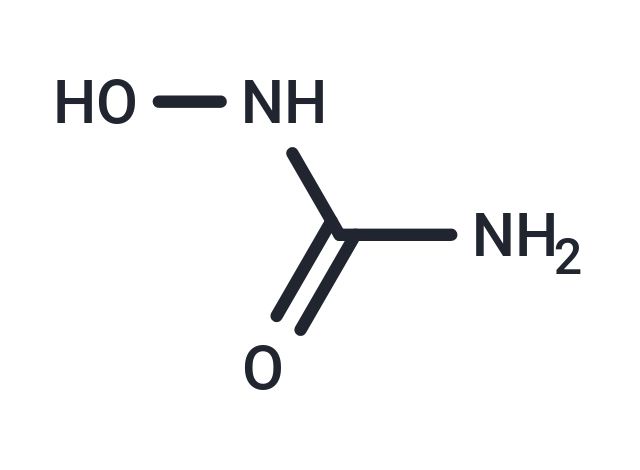Shopping Cart
Remove All Your shopping cart is currently empty
Your shopping cart is currently empty
Hydroxyurea (Hydroxycarbamide), an antineoplastic agent, inhibits DNA synthesis through the inhibition of ribonucleoside diphosphate reductase.

| Pack Size | Price | USA Warehouse | Global Warehouse | Quantity |
|---|---|---|---|---|
| 500 mg | $45 | In Stock | In Stock | |
| 1 g | $53 | In Stock | In Stock | |
| 1 mL x 10 mM (in DMSO) | $50 | In Stock | In Stock |
| Description | Hydroxyurea (Hydroxycarbamide), an antineoplastic agent, inhibits DNA synthesis through the inhibition of ribonucleoside diphosphate reductase. |
| In vitro | hydroxyurea can inhibit HIV-1 replication. In vitro experiments have shown that the 90% inhibitory concentration (IC90) of hydroxyurea for laboratory strains of HIV-1 in activated PBMC is 0.4 mM. Hydroxyurea was also found to be synergistic with the nucleoside reverse transcriptase inhibitor didanosine and to inhibit HIV-1 replication in activated PBMC; this inhibition may be due to a reduction in deoxynucleoside triphosphate pool sizes. Hydroxyurea has been shown to sensitize didanosine-resistant mutants[1][2].hydroxyurea has demonstrated activity in the treatment of sickle cell anemia by increasing the production of fetal hemoglobin, which reduces hemolysis in patients with this disease. Hydroxyurea exerts its cytostatic effect through inhibition of ribonucleotide reductase—the rate-limiting enzyme responsible for the conversion of ribonucleotides to deoxyribonucleotides, which are essential for DNA synthesis. As a result, cellular division is arrested in the S phase[1]. |
| In vivo | Hydroxyurea treatment consistently decreases white blood cell (WBC) and absolute neutrophil count (ANC), yet does not enhance anemia over a 17-week period. At a dosage of 50 mg/kg, hydroxyurea effectively lowers WBC and ANC without ameliorating anemia in comparison to vehicle-treated sickle cell mice [5]. |
| Cell Research | Erythroid cells obtained from peripheral blood of the same patients(Thirteen β-Thal/HbE patients are treated with hydroxyurea orally for 2 years at a starting dose of 5 mg/kg/day for 5 days/week with escalation to a maximum of 10 mg/kg/day) 1 year after they had stopped hydroxyurea treatment are treated with hydroxyurea in vitro.Treatment of cells performs in primary culture with 30 μM hydroxyurea for 96 hours.(Only for Reference) |
| Synonyms | nsc32065, nci-c04831, Hydroxycarbamide |
| Molecular Weight | 76.05 |
| Formula | CH4N2O2 |
| Cas No. | 127-07-1 |
| Smiles | NC(=O)NO |
| Relative Density. | 1.457g/cm3 |
| Storage | Powder: -20°C for 3 years | In solvent: -80°C for 1 year | Shipping with blue ice/Shipping at ambient temperature. | |||||||||||||||||||||||||||||||||||
| Solubility Information | DMSO: 255 mg/mL (3353.06 mM), Sonication is recommended. H2O: 55 mg/mL (723.21 mM), Sonication is recommended. | |||||||||||||||||||||||||||||||||||
| In Vivo Formulation | 10% DMSO+40% PEG300+5% Tween 80+45% Saline: 5 mg/mL (65.75 mM), Sonication is recommended. Please add the solvents sequentially, clarifying the solution as much as possible before adding the next one. Dissolve by heating and/or sonication if necessary. Working solution is recommended to be prepared and used immediately. The formulation provided above is for reference purposes only. In vivo formulations may vary and should be modified based on specific experimental conditions. | |||||||||||||||||||||||||||||||||||
Solution Preparation Table | ||||||||||||||||||||||||||||||||||||
H2O/DMSO
| ||||||||||||||||||||||||||||||||||||
| Size | Quantity | Unit Price | Amount | Operation |
|---|

Copyright © 2015-2025 TargetMol Chemicals Inc. All Rights Reserved.